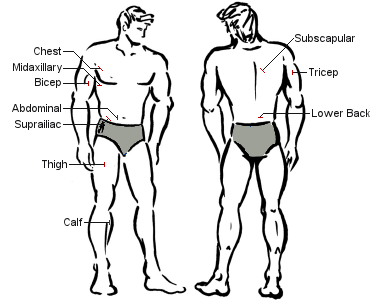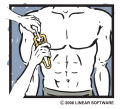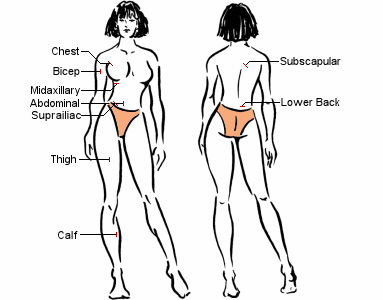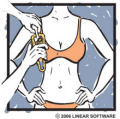Miss Candace
This weeks subject: THE SECRET OF HOW TO INTERPRET A FOOD LABEL
Jan 19, 2010
This article (from the OH home page) stuck out to me as I am currently taking a nutrition class.
As someone who is trying to lead a healthier lifestyle, I have to admit that reading the label is not something that I often do (if ever). In fact, I find it quite cumbersome - which leads to my purchasing foods that are quicker/easier to prepare, but less nutrious.
Hopefully, this will help me stay focused, throughout the year, on making the right food choices - instead of going for what's right in front of me or what's easier/cheaper (which will lead to the reduction of body fat & weight loss).
|
“You need to eat less calories, exercise more and choose healthier foods.” Does this sound familiar? Often times after leaving a doctor’s appointment and being informed about your ever rising cholesterol levels, borderline blood pressure and excessive weight gain, you leave the office with these words of wisdom. It sounds like a great idea but as you start to think about your plan of action, you often wonder what these code words mean. It seems as though you need to figure out how to decipher the code to become successful in obtaining your doctor’s wishes in improving your health, but at the same time you struggle in trying not to lose your sense of satisfaction of fulfillment when nourishing your body. Just how much do you give up to obtain a healthy lifestyle without compromising the joy you experience from eating your favorite foods? As a Registered Dietitian, I have witnessed this transition from bariatric pre-op to bariatric post op. It may be difficult, as it will take some work and effort on your part, especially in the beginning as you learn how to retrain your body into craving specific food items. Understanding food labels and knowing what to look for while grocery shopping is the starting point to your success in becoming a healthier you. Depending on your personal goals, there are specific items you should target for your individual needs. As a post bariatric patient, protein is a very important food component. It is not only is used for growth and repair of the human body, but since carbohydrates are limited due to potential dumping syndrome (such as nausea, vomiting, diarrhea), protein is also used as a source of energy. Therefore, when reading a food label, the first item you should review is the amount of protein in that product. The values will differ from various food sources, i.e. animal protein will contain a larger amount of protein than a piece of fruit or a vegetable would. This means the higher the protein, the more beneficial. |
|
|
Carbohydrates are the next important item on the food label as it provides energy for the brain and muscles. Sugar and fiber fall under the umbrella term carbohydrate. There are “good carbohydrates” that are low on the glycemic index and are high in fiber to help sustain one’s appetite and energy levels; then, there are “bad” carbohydrates that are very high on the glycemic index which do not sustain energy for long periods of time. For example, a piece of whole grain bread will contain more fiber and less sugar than a candy bar, helping to increase the length of feeling full in between meals and also helping with proper GI motility. It is very important to understand the difference between a high fiber carbohydrate source versus a high sugar carbohydrate source. | |
 |
This week's subject: % of BODY FAT
Jan 14, 2010
Understanding Your Body Fat Percentage http://www.healthchecksystems.com/bodyfat.htm
Body fat measurements and the measuring tape are recognized as superior methods for measuring "weight loss". When one declares that they want to "lose weight", what they often mean is that they want to lose fat. So, now that you've had your body fat percentage measured, what does the number really mean? 
First, your body fat percentage is simply the percentage of fat your body contains. If you are 150 pounds and 10% fat, it means that your body consists of 15 pounds fat and 135 pounds lean body mass (bone, muscle, organ tissue, blood and everything else).
A certain amount of fat is essential to bodily functions. Fat regulates body temperature, cushions and insulates organs and tissues and is the main form of the body's energy storage. The following table describes body fat ranges and their associated categories:
*General Body Fat Percentage Categories
| Classification | Women (% fat) | Men (% fat) |
|---|---|---|
| Essential Fat | 10-12% | 2-4% |
| Athletes | 14-20% | 6-13% |
| Fitness | 21-24% | 14-17% |
| Acceptable | 25-31% | 18-25% |
| Obese | 32% plus | 25% plus |
Knowing your body fat percentage can also help you determine if your weight loss goals are realistic. Remember, weight loss doesn't always mean fat loss. For example:
Let's say you're a 130# woman with 23% body fat, and you goal is to "lose 20 pounds":
Initial body fat: 130# x 0.23 fat = 30 # body fat
Lean body mass: 130# total - 30# fat = 100# lean body mass (bones, organs and all else)
Goal: 130# - 20# = 110 pounds
As you can see, the goal of losing 20 pounds is not realistic or healthy. At 110 pounds, this woman still requires 100# of lean body mass (bones, organs, etc.), but would only be carrying 10#, or only 9% body fat. From the chart above, you can see that this is a dangerously low percentage.
A better goal might be for the woman to reduce her body fat from 23% to 18%. In this case:
130# x 0.18 = 23 # body fat
100# lean body mass + 23 # = 123# goal weight
So, for this individual to achieve a lean, but healthy 18% fat, she would need to lose only 7 pounds of fat, reducing her weight from her current 130 pounds to 123 pounds. Losing more than 7 pounds means losing lean body mass (usually metabolically-active muscle tissue), which is clearly not desirable.
So before you decide that you need to "lose weight", remember to consider that "weight" consists of both lean body mass and body fat. Try to keep your weight loss goals realistic, and remember, keep the calorie-burning muscle, and lose only the fat.
To help reinforce this practice/habit, I found the following data & body fat calculator at
Online Body Fat Calculator for Men and Women.
However, to ensure you receive accurate data, you will have to visit the site at http://www.linear-software.com/online.html to use the calculator tool as not all of the fields are importing on this end properly.
 Body Fat Caliper Measurement Sites - Men
Body Fat Caliper Measurement Sites - Men
Chest - Diagonal fold, midway between upper armpit and nipple
Midaxillary - Horizontal fold, directly below armpit
Bicep - Vertical fold, halfway between shoulder and elbow, directly on bicep
Abdominal - Vertical fold, one inch to the right of navel
Suprailiac - Diagonal fold, directly above iliac crest
Thigh- Vertical fold, midway between knee cap and top of thigh
Calf - Vertical fold, inside of leg on largest part of calf
Subscapular - Diagonal fold, directly below shoulder blade
Tricep - Vertical fold, midway between elbow and shoulder
Lower Back - Horizontal fold, directly over the kidneys, and 2 inches to the right of spine
 Click here for images for body fat calculator measurement sites
Click here for images for body fat calculator measurement sites
![]()
Body Fat Caliper Procedures1
1.) All measurement should be made on the right side of the body
2.) Caliper should be placed 1 cm away from thumb and finger, perpendicular to skinfold, and halfway between crest and base of fold
3.) Pinch should be maintained while reading the caliper
4.) Wait 1 to 2 s (and not longer) before reading caliper
5.) Take duplicate measures at each site and retest if duplicate measurements are not within 1 to 2 mm
6.) Rotate through measurement sites or allow time for skin to regain normal texture and thickness
![]()
1American College of Sports Medicine. ACSM's Guidelines For Exercise Testing and Prescription. 6th Edition. USA, Lippincott Williams & Wilkins 2000;65.

Chest - Diagonal fold, one third of the way between upper armpit and nipple
Midaxillary - Horizontal fold, directly below armpit
Bicep - Vertical fold, halfway between shoulder and elbow, directly on bicep
Abdominal - Vertical fold, one inch to the right of navel
Suprailiac - Diagonal fold, directly above iliac crest
Thigh- Vertical fold, midway between knee cap and top of thigh
Calf - Vertical fold, inside of leg on largest part of calf
Subscapular - Diagonal fold, directly below shoulder blade
Tricep - Vertical fold, midway between elbow and shoulder
Lower Back - Horizontal fold, directly over the kidneys, and 2 inches to the right of spine
 Click here for images for body fat calculator measurement sites
Click here for images for body fat calculator measurement sitesBody Fat Caliper Procedures1
1.) All measurement should be made on the right side of the body
2.) Caliper should be placed 1 cm away from the thumb and finger, perpendicular to the skinfold, and halfway between the crest and the base of the fold
3.) Pinch should be maintained while reading the caliper
4.) Wait 1 to 2 s (and not longer) before reading caliper
5.) Take duplicate measures at each site and retest if duplicate measurements are not within 1 to 2 mm
6.) Rotate through measurement sites or allow time for skin to regain normal texture and thickness
1American College of Sports Medicine. ACSM's Guidelines For Exercise Testing and Prescription. 6th Edition. USA, Lippincott Williams & Wilkins 2000;65.
Here's to conquering body fat!
2010 & still fighting the battle
Jan 14, 2010

Well, here we are, 2010 & I am still trying to get back down to 160. Since i last checked in (in 2008), i managed to "find" approx. 20 lbs. & I'm struggling to get back down.
It seems that every year i reach a crisis point with my weight & scream to the heavens BACK TO BASICS but MAN how i wish i could learn my lesson & just reach & maintain my goal of 160... even 180... but ideally 160.
So I'm back to using all of my tools. The 5dpt (love it), online tracking here, on thedailyplate.com & on mapmywalk.com (that's a great tool!!) in hopes that actually SEEING what I'm consuming, how that's being absorbed, what my physical activity is will help snap me out of it & get me where i want to be.
My last post (in 2008) revolved around the subject of how important taking our vits are (love you Anita!!!). I stayed on that soap box for about a month & then fell off as my weight creeped back up. Moving forward, I'm really going to try to break that habit.
However, that made me realize that I don't know a lot about nutrition & how my body reacts to the food choices i make. Truth be told, nutrition is kind of a guessing game for me & I believe that is a large part of the battle - KNOWLEDGE. So I figured I'd use this forum to post about topics that I find challenging or really didn't know a lot about or completely understand. For one, it will serve as a personal reminder & two, perhaps my research will help some of you with your battle (I cant be the only one who doesnt quite get it).
Best of luck to us all.
Wake up calls from the WLS Grad board
Jul 13, 2008
I would guess that this first one is from Anita & she's absolutley right!!
1st Mistake: Not Taking Vitamins, Supplements, or Minerals Every WLS patient has specific nutritional needs depending on the type of surgery you have had. Not only is it a good idea to ask your surgeon for guidelines, but also consult with an experienced WLS nutritionist. Understand there is not a standard practice that all surgeons and nutritionists follow in guiding WLS patients. So, it is important to do your own research, get your lab tests done regularly, and learn how to read the results. Some conditions and symptoms that can occur when you are deficient in vitamins, supplements, or minerals include: Osteoporosis; pernicious anemia; muscle spasms; high blood pressure; burning tongue; fatigue; loss of appetite; weakness; constipation and diarrhea; numbness and tingling in the hands and feet; being tired, lethargic, or dizzy; forgetfulness, and lowered immune functioning. Keep in mind, too, that some conditions caused by not taking your vitamins, supplements, or minerals are irreversible.
2nd Mistake: Assuming You Have Been "Cured" of Your Obesity A "pink cloud" or honeymoon experience is common following WLS. When you are feeling better than you have in years, and the weight is coming off easily, it's hard to imagine you will ever struggle again. But unfortunately, it is very common for WLS patients to not lose to their goal weight or to regain some of their weight back. A small weight regain may be normal, but huge gains usually can be avoided with support, education, effort, and careful attention to living a healthy WLS lifestyle. For most WLSers, if you don't change what you've always done, you're going to keep getting what you've always gotten -- even after weight loss surgery.
3rd Mistake: Drinking with Meals Yes, it's hard for some people to avoid drinking with meals, but the tool of not drinking with meals is a critical key to long-term success. If you drink while you eat, your food washes out of your stomach much more quickly, you can eat more, you get hungry sooner, and you are at more risk for snacking. Being too hungry is much more likely to lead to poor food choices and/or overeating.
4th Mistake: Not Eating Right Of course everyone should eat right, but in this society eating right is a challenge. You have to make it as easy on yourself as possible. Eat all your meals--don't skip. Don't keep unhealthy food in sight where it will call to you all the time. Try to feed yourself at regular intervals so that you aren't as tempted to make a poor choice. And consider having a couple of absolutes: for example, avoid fried foods completely, avoid sugary foods, always use low-fat options, or only eat in a restaurant once a week. Choose your "absolutes" based on your trigger foods and your self knowledge about what foods and/or situations are problematic for you.
5th Mistake: Not Drinking Enough Water Most WLS patients are at risk for dehydration. Drinking a minimum of 64 oz. of water per day will help you avoid this risk. Adequate water intake will also help you flush out your system as you lose weight and avoid kidney stones. Drinking enough water helps with your weight loss, too.
6th Mistake: Grazing Many people who have had WLS regret that they ever started grazing, which is nibbling small amounts here and there over the course of the day. It's one thing to eat the three to five small meals you and your doctor agree you need. It's something else altogether when you start to graze, eating any number of unplanned snacks. Grazing can easily make your weight creep up. Eating enough at meal time, and eating planned snacks when necessary, will help you resist grazing. Make a plan for what you will do when you crave food, but are not truly hungry. For example, take up a hobby to keep your hands busy or call on someone in your support group for encouragement.
7th Mistake: Not Exercising Regularly Exercise is one of the best weapons a WLS patient has to fight weight regain. Not only does exercise boost your spirits, it is a great way to keep your metabolism running strong. When you exercise, you build muscle. The more muscle you have, the more calories your body will burn, even at rest!
8th Mistake: Eating the Wrong Carbs (or Eating Too Much) Let's face it, refined carbohydrates are addictive. If you eat refined carbohydrates they will make you crave more refined carbohydrates. There are plenty of complex carbohydrates to choose from, which have beneficial vitamins. For example, if you can handle pastas, try whole grain Kamut pasta--in moderation, of course. (Kamut pasta doesn't have the flavor some people find unpleasant in the whole wheat pastas.) Try using your complex carbohydrates as "condiments," rather than as the center point of your meal. Try sprinkling a tablespoon of brown rice on your stir-fried meat and veggies.
9th Mistake: Going Back to Drinking Soda Drinking soda is controversial in WLS circles. Some people claim soda stretches your stomach or pouch. What we know it does is keep you from getting the hydration your body requires after WLS--because when you're drinking soda, you're not drinking water! In addition, diet soda has been connected to weight gain in the general population. The best thing you can do is find other, healthier drinks to fall in love with. They are out there.
10th Mistake: Drinking Alcohol If you drank alcohol before surgery, you are likely to want to resume drinking alcohol following surgery. Most surgeons recommend waiting one year after surgery. And it is in your best interest to understand the consequences of drinking alcohol before you do it. Alcohol is connected with weight regain, because alcohol has 7 calories per gram, while protein and vegetables have 4 calories per gram. Also, some people develop an addiction to alcohol after WLS, so be very cautious. Depending on your type of WLS, you may get drunker, quicker after surgery, which can cause health problems and put you in dangerous situations.
Start communicating w/ your pouch again
Jun 26, 2008

I lost control of my weight loss and in my forth year out, I had re-gained 60lbs from my lowest weight.
Are you asking:
Does my pouch still work?
Have I broken my pouch? (or stretched it out too much?)
Am I doomed to be a failure at this too?
Can I lose the weight I've regained?
Is the honeymoon period over?
I never made it to goal weight and now I'm gaining. Help!
I asked all of these questions & came running back to OH.com for help. I was so completely lost & clueless on how to gain control & re-lose that weight. A dear OH friend referred me to the WLS Grad board where I found out about this 5DPT.
If you are asking these questions then the 5 Day Pouch Test is for you. In 5 Days you can rediscover your pouch, get back on track and lose weight with your weight loss surgery tool. You have not failed! You can learn to use the tool again!
Take me to the 5 Day Pouch Test!
Take it.
Face your carb demond  & re-gain control over your weight and over your life. You've come too far to give up on everything now.
& re-gain control over your weight and over your life. You've come too far to give up on everything now.
You can do this!
Make it happen.
Updating the new profile page
Jun 24, 2008
Approx. Height: 5'5"
PreOp Weight: 292
Lowest Weight: 165
Current Weight: 218
Goal Weight: 160
PreOp BMI: 47
Current BMI: 36.6
Goal BMI: 26.6
BMI Weight Status
Below - 18.5 Underweight
18.5 – 24.9 Normal
25.0 – 29.9 Overweight
30.0 and Above Obese ~*~*~*~*~*~*~*~*~*~*~*~*~*~*~*~*~*~*~*~*~*~*~*~*~*~*~*~*~*~
Goal Setting:
Name: Back to Bacis
Purpose:
I am committing to getting back on track & dropping 60lbs by Dec 2008.
How will I achieve this?:
By taking control of my physical health & scheduling in time for fitness. I am committed to biking to work at least 3x/week & elevation hike for at least 6 miles every weekend. In addition, I will participate in extra activities like kayaking & white water rafting.
I will succeed in doing the 5DPT & will participate in it at least 2 weeks out of the month.
I will drink more water, protein shakes, & continue taking my vitamins. ~*~*~*~*~*~*~*~*~*~*~*~*~*~*~*~*~*~*~*~*~*~*~*~*~~*~*~*~*~*~*~
Weight Chart:
6/18/08: (full on panic has set in!!) 218
8/4/06: 178 (Dont panic - just get back to the basics!)
12/15/05: 172 **:(( DAYUM those Holidays!! X(**
9/22/05: 160
4/22/05: 166.4 (1 year post op)
10/27/04: 183.5
9/15/04: 186
8/10/04: 189 (1 year since i "started my journey" & down 100 lbs.)
7/27/04: 200
6/2/04: 235
4/29/04: 248.5!!!! :O DANG!!!! thats down 15.5 - 10.5lbs!!!!
4/22/04: **SURGERY DAY!!** 264 @the hosp./ 259 @at the house
4/5/04: 260
3/3/04: 263
2/20/04: 265
1/5/04: 267.5
11/10/03: 278
11/3/03: 278.5
10/31/03: 281 (PHEW! thats better)
10/15/03: 289.6 :(( I'm going the wrong way!!!
9/25/03: 288
9/16/03: 292
8/11/03: 287
